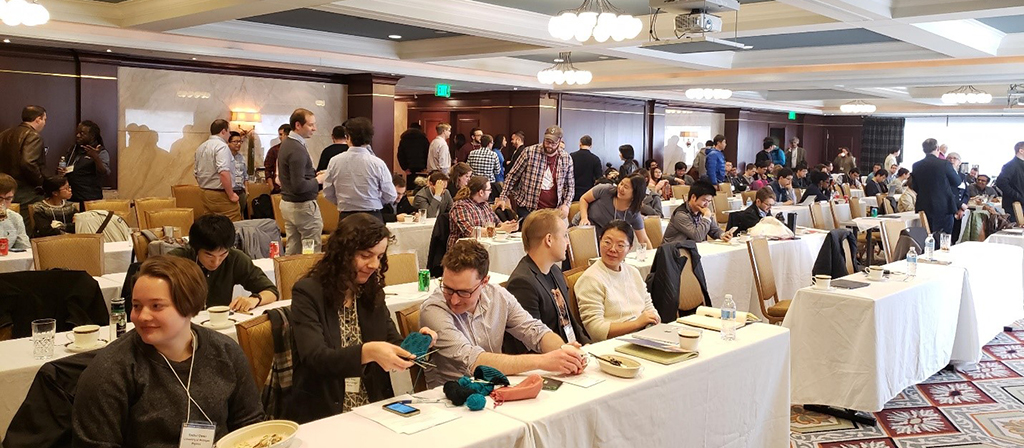The new quantum spurs action by the Michigan Quantum Science & Technology Working Group
The new working group showcased Michigan’s strength in Quantum Science at a workshop attended by researchers throughout the University of Michigan.

 Enlarge
Enlarge
The world as we see it has been effectively explained by Newtonian physics for about three centuries. Matter invisible to the eye, however, had been operating under its own unique principles. Researchers at Michigan have been studying this atomic and sub-atomic quantum realm for decades, and have now formed a working group to pool their collective wisdom in the area of quantum science. Called the Michigan Quantum Science & Technology Working Group (MQSTWG), their goal is to be a force in the coming age of quantum-generated technology.
“Quantum technology is still in the vacuum-tube [ie, pre-transistor] era,” says MQSTWG co-chair Mackillo Kira, professor of electrical engineering and computer science. “Revolutionary advances in electronic and optoelectronic devices, imaging, information science, and chemical reactions will be enabled in the not-too-distant future.”
These advances will have a major impact on next-generation transistors, light sources, and sensing for applications such as quantum information processing and computing, detection of stealth airplanes, mapping of the cosmic microwave background, new materials for next-generation electronic devices, ultra-secure communications, and solar-based fuel, to name a few.
Steve Cundiff, the Harrison M. Randall Collegiate Professor of Physics and co-chair of the MQSTWG, recently participated in the White House Academic Roundtable on Advancing American Leadership in Quantum Information Science as one of approximately 25 invited participants nationwide. According to the official report, “the event marked the re-charter of the National Science and Technology Council’s (NSTC) subcommittee on QIS to reflect its role in coordinating the National Quantum Initiative.”
The Michigan Quantum Science & Technology Working Group consists of 16 faculty from 7 departments, including Electrical Engineering and Computer Science, Physics, Materials Science and Engineering, Chemistry, Astronomy, Biophysics, and Mathematics.

 Enlarge
Enlarge
The working group is representative, but not inclusive, of all the faculty working in quantum science and technology at Michigan. However, not even the Chairs were expecting the 175+ attendees at their first Michigan Quantum Science and Technology Workshop this past April. The Workshop attracted a diverse group ranging from undergraduate students to seasoned researchers from 12 different departments across the university and beyond.
Six Michigan and eight external speakers (from Facebook, Michigan State University, Ohio State University, Purdue University, Stanford, University of Chicago, University of Oregon, and Virginia Tech) offered a glimpse into what’s happening in the quantum realm.
Michigan faculty offered talks on quantum materials synthesis (Rachel Goldman, materials science & engineering); quantum theory (Mack Kira, electrical engineering and computer science); laser spectroscopy (Ted Norris, Gérard A. Mourou Professor of Electrical Engineering and Computer Science); quantum sensing (Lu Li, physics); quantum science of chemical and biological systems (Eitan Geva, chemistry); and quantum optics and photonics (Hui Deng, physics).
While attendees were primarily academics, seven companies ranging from Michigan startups to large corporations attended as well.
“We want to strengthen our connections to industry,” said Kira, “so we can work together to advance the field.”
An interdisciplinary mindset, bringing together researchers from different disciplines, institutions, and industries, is at the core of the MQSTWG.
“A lot of the basic science has been historically developed in physics,” said Cundiff. “But at the same time, it has spanned into electrical engineering, computer science, materials science, chemistry, and this is just to name a few. Our working group spans the entire university, and it was great to see so many people from different disciplines getting the chance to network during the Workshop.”
Quantum-based advances are being supported by the National Quantum Initiative Act, signed into law December 26, 2018. This 10-year plan aims to accelerate quantum information science & technology applications.
“There’s no better time and place to be engaging in quantum R&D than right now in the United States. Our Nation is on the verge of incredible breakthroughs in this emerging technology,” said Dr. Kelvin K. Droegemeier, Director of the White House Office of Science and Technology Policy.
The New Quantum
Investigation into the quantum realm took off in the early 20th century when Planck, Einstein, and others offered theories of this unseen world. But it took decades and more before some of these theories could be proven through experimentation. The processes were simply too miniscule and fleeting to measure. Once the tools caught up to the theory, Michigan researchers began contributing to quantum-based research and breakthroughs.
It was a team of Michigan researchers, led by Pallab Bhattacharya, Charles M. Vest Distinguished University Professor, that discovered quantum dots in the early 1980’s. This led to the development of a wide array of optoelectronic devices in the marketplace, and is still an active research area.
Duncan Steel, Robert J. Hiller Professor, and colleagues were the first to demonstrate that quantum dots could be controlled, and later to prove the mysterious phenomenon known as quantum entanglement, while also proving that the process is scalable.
More recently, Steel and P.C. Ku contributed to the first optically controlled two-qubit gate out of a semiconductor quantum dot. Ku is taking this further to build a quantum network, and Kira’s own collaborative and interdisciplinary research is bringing us closer to practical quantum computing through a new technique to manipulate electrons with light.
Stephen Forrest, Peter A. Franken Distinguished University Professor, was part of a multi-institutional team to prove that light can act as photon glue that binds together the quantum mechanical properties of two vastly different materials. The effect could harness the most useful characteristics from each material for hybrid solar cells and high efficiency lighting, among other applications.
Zetian Mi is leading a 12-member team from five different departments in a project to develop new ways to control and use quantum particles such as excitons, polaritons, and dropletons. This work could help address access to clean water with more efficient ultraviolet LEDs, and create a new source of renewable fuels through more efficient production of solar fuels using artificial photosynthesis.
Alex Kuzmich, Martin L. Perl Collegiate Professor of Physics, leads a group that investigates realizations of scalable quantum networks based on trapped ultra-cold atoms. Among their results are the first realization of the quantum state transfer between matter and light, the first achievement of remote entanglement between matter qubits, a demonstration of a quantum memory with storage time of many seconds, and the first realization of a Rydberg-based source of single photons.
And finally, Cundiff and Kira have collaborated on several papers over the past two decades, including a 2014 article published in Nature, “Quantum droplets of electrons and holes,” where they were members of a team that identified a new quantum quasiparticle called a dropleton.
These are just a few examples of Michigan’s involvement in quantum science and technology. Departments with strong quantum research efforts include electrical engineering and computer engineering science, physics, materials science & engineering, mechanical engineering, chemical engineering, and nuclear engineering & radiological sciences.
Educating the New Quantum
Several long-standing and new courses are specifically devoted to educating the next generation of specialists in quantum science and technology. In addition to traditional courses such as Applied Quantum Mechanics I and II, Solid State Physics, and Quantum Theory of Light, new specific quantum technology courses have recently been introduced to the curriculum.
For example, the new “Introduction to Quantum Nanotechnology” course exposes undergraduate and graduate students to the latest trends in quantum technology. At the graduate level, “Quantum Optoelectronics” teaches the key concepts needed to quantum engineer next-generation semiconductor-based quantum devices.
“If you want to encounter the bizarre possibilities of the quantum realm – only enthusiasm and basic knowledge about quantum mechanics and electromagnetism is required,” said Kira.
Michigan is particularly strong in theory, laser spectroscopy, semiconductor quantum optics and photonics, quantum materials, quantum chemical and biological systems, quantum sensing, and the ability to build complex many-body systems.
Cundiff and Kira expect that the Michigan Quantum Science & Technology Working Group is the first step towards a larger organized unit within the University, similar to recent initiatives in Data Science, Robotics, and Precision Health. Right now, this working group is serving as a nexus and veritable think tank to facilitate and support Michigan’s continued leadership in the area of quantum science and technology.
 MENU
MENU 
